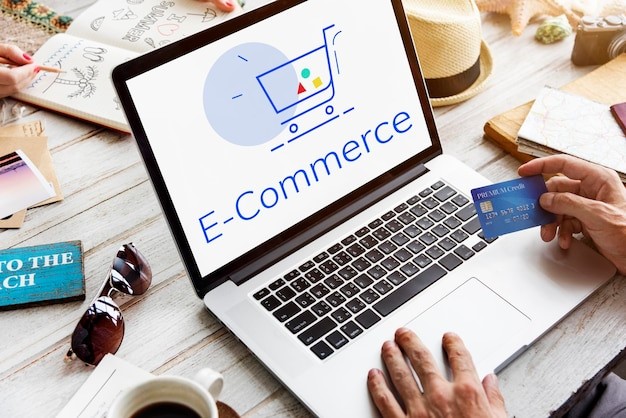Introduction
In the modern, rapid digital landscape, ecommerce acts as a portal to limitless possibilities. As online shopping becomes more popular, along with adaptable business structures and minimal entry obstacles, numerous hopeful entrepreneurs inquire, “Is ecommerce truly lucrative?” The response is a clear yes—when tackled strategically.
What makes ecommerce especially attractive is its ease of access. In contrast to conventional physical businesses, launching an ecommerce store demands much less initial capital, making it an accessible choice for those with few resources. Furthermore, the worldwide aspect of the internet enables companies to access various markets, overcoming geographical constraints that once hindered expansion. This blend of cost-effectiveness, accessibility, and scalability has allowed numerous entrepreneurs to transform creative concepts into successful businesses.
This guide investigates the average income of a successful ecommerce business, examines the elements that enhance profitability, and offers practical tactics for growth. Through examples and practical case studies, this in-depth examination will demonstrate how companies, irrespective of their size or sector, can attain substantial growth in the competitive ecommerce environment.

What Is the Average Income of a Successful ecommerce Business?
The success of an ecommerce business relies on its size, market segment, intended customers, and business tactics. Comprehending revenue standards among various business sizes offers insight for hopeful entrepreneurs.
Small Businesses
- Annual Revenue: $50,000–$100,000
Small ecommerce ventures frequently function as side jobs or passion initiatives. With low overhead and specific audiences, these businesses often concentrate on niche markets like handmade items, customized services, or limited product ranges. They frequently depend on affordable platforms like Squarespace or Wix and employ economical marketing strategies like organic social media and word-of-mouth recommendations.
Although the revenue may be modest, small businesses can attain significant profitability by maintaining low operational costs and targeting specific, dedicated customer groups. Nevertheless, obstacles like limited scalability and restricted resources make it essential to focus on efficient processes and customer satisfaction to achieve further growth.
Medium Businesses
- Annual Revenue: $500,000–$1 million
Medium-sized companies have moved past the startup stage and usually function in specific niches while emphasizing branding and steady customer interaction. These companies invest in scalable platforms such as Shopify or WooCommerce, allowing them to oversee inventory, incorporate advanced marketing tools, and broaden their reach.
At this stage, revenue expansion is derived from marketing initiatives, such as paid ads, partnerships with influencers, and email marketing campaigns. Medium-sized businesses likewise expand their product range to draw in returning customers and boost average order values. Attaining sustainable growth necessitates harmonizing operational efficiency with creative marketing strategies.
Large Enterprises
- Annual Revenue: : Billions
Major players such as Amazon, Walmart, and Alibaba lead the ecommerce arena with vast product inventories, advanced technology, and worldwide logistics systems. These firms create enormous income by utilizing economies of scale, tailored customer experiences, and sophisticated analytics.
Although these companies represent the pinnacle of how much ecommerce businesses make, smaller businesses can learn valuable lessons from their strategies, such as data-driven decision-making, customer-centric approaches, and streamlined operations.
See More: 7 Tips for Personal Logo Design for Startups That Will Turn Brands Around.
Factors That Drive ecommerce Revenue
Several factors influence how much ecommerce businesses make. From platform choice to marketing strategies, these elements can make or break profitability.
1. Platform Selection
The platform you choose determines your store's functionality, scalability, and overall performance. Selecting the right one is crucial for optimizing operations and maximizing profitability. Here’s a closer look at the top platforms:
- Squarespace: Known for its elegant templates and simplicity, Squarespace is ideal for visually focused brands like artists, photographers, and boutique shops. While it offers a polished experience for small-scale businesses, it lacks the advanced tools needed for scaling.
- Shopify: A favorite among growing ecommerce brands, Shopify offers robust features such as inventory management, third-party integrations, and marketing automation. Its scalability makes it ideal for businesses seeking long-term growth.
- Wix: As a beginner-friendly platform, Wix allows users to set up stores with ease through its drag-and-drop builder. However, its limited scalability and fewer advanced tools make it less suitable for larger operations.
Example: A handmade soap company initially used Wix due to its affordability and simplicity. As sales grew, they transitioned to Shopify to access advanced analytics, marketing integrations, and automation tools. The result? A 350% increase in revenue within two years.
This comparison—Squarespace vs Shopify vs Wix shows that choosing the right platform directly impacts growth potential and profitability.
2. Niche Selection
Selecting the right niche is one of the most critical factors in ecommerce profitability. A well-defined niche allows businesses to target a specific audience, differentiate themselves from competitors, and maximize profit margins.
- High-Profit Niches: Examples include eco-friendly products, luxury goods, and subscription-based services. These niches often feature higher margins due to perceived value and exclusivity.
- Saturated Niches: Markets like electronics or general apparel are highly competitive, often leading to slim profit margins and intense pricing wars.
Focusing on niches with underserved audiences or unique value propositions ensures higher profitability and customer loyalty. For instance, selling personalized pet accessories targets a passionate niche that values customization over price.
3. Marketing and Branding
Marketing plays a pivotal role in driving traffic, conversions, and repeat business. Successful ecommerce brands allocate 10–20% of their revenue to marketing efforts. Here are the most effective strategies:
- Social Media Advertising: Facebook, Instagram, TikTok, and other platforms are excellent for focusing on particular demographics.
- Search Engine Optimization (SEO): Organic traffic from search engines is one of the most cost-effective ways to attract customers. Optimizing for terms like custom WordPress development services or ecommerce website development companies in the USA improves visibility.
- Email Marketing: Personalized emails for cart abandonment, product recommendations, and exclusive offers increase customer retention and lifetime value.
- Influencer Collaborations: Partnering with niche influencers builds credibility and expands reach.
4. Website Design and User Experience
To turn visitors into buyers, a smooth user experience is essential. Investing in professional website design ensures the following:
- Mobile Responsiveness: With over 50% of ecommerce transactions occurring on mobile devices, a responsive design is essential.
- Intuitive Navigation: Simplified navigation helps users find what they need quickly, reducing bounce rates.
- Strong Visual Identity: High-quality graphic design in business, consistent branding, and visually appealing layouts establish trust and credibility.
The Role of Custom Development in ecommerce Success
Custom development offers tailored solutions that help ecommerce businesses address unique challenges and scale effectively. Unlike template-based platforms, custom-built websites provide:
- Personalized Features: Custom development allows businesses to include features like product recommendation algorithms, loyalty programs, or unique checkout processes.
- SEO Optimization: A custom site structure ensures better performance in search engine rankings, driving organic traffic.
- Scalability: As your business grows, custom solutions make it easier to add features and handle increased traffic.
Case Study: A health supplement company upgraded from a pre-built Shopify template to a custom WordPress site. The result was a 50% increase in organic traffic and a 200% boost in sales due to faster load times, personalized features, and improved search rankings. This highlights the value of custom WordPress development services for scaling businesses effectively.
Strategies for Scaling Your ecommerce Business
Scaling your ecommerce business is essential for sustained profitability. Here’s how to expand effectively:
- Upselling and Cross-Selling: Increase average order value (AOV) by encouraging customers to add more items to their carts.
- Expanding to New Markets: Reach global audiences by offering international shipping, currency options, and localized websites.
- Investing in Analytics: Analytics tools help track customer behavior, identify top-performing products, and refine marketing campaigns.
- Leveraging Automation: Automation tools streamline operations, from inventory management to marketing campaigns.
- Optimizing for Mobile Users: With mobile commerce booming, ensure your site is fully optimized for smaller screens.
Why Is Branding Important for ecommerce?
Branding is a cornerstone of success for any ecommerce business, as it helps businesses establish trust, create emotional connections, and differentiate themselves from competitors. A strong brand identity influences purchasing decisions and fosters customer loyalty, which is essential for long-term profitability.
- Building Trust: In the online world, customers cannot physically inspect products before purchasing. A cohesive brand identity—with consistent visuals, tone, and messaging—helps create a professional appearance that builds credibility. High-quality graphic design in business, such as a memorable logo, well-designed product packaging, and an intuitive website layout, plays a significant role in making a positive first impression.
- Creating Emotional Connections: A strong brand tells a story and resonates with the target audience on an emotional level. For example, brands that champion sustainability or social causes often attract passionate, loyal customers. These emotional connections not only increase initial conversions but also encourage repeat purchases and word-of-mouth referrals.
- Standing Out in Competitive Markets: In saturated markets, branding is often the deciding factor for customers choosing between similar products. Unique value propositions, a compelling brand voice, and visually distinct marketing materials help businesses rise above the noise. For instance, a brand specializing in handmade jewelry can emphasize craftsmanship and exclusivity through storytelling and a consistent aesthetic.
- Driving Customer Loyalty and Conversions: Branding isn’t just about attracting customers—it’s also about retaining them. When customers associate a brand with quality and trustworthiness, they’re more likely to return for future purchases. Moreover, loyal customers are more likely to recommend your brand to others, creating a ripple effect that drives organic growth.
Real-Life Example: A small skincare company faced challenges in standing out within a saturated market. Following their investment in professional branding—featuring tailored packaging, an aesthetically pleasing website, and a unified social media approach—they experienced a 200% rise in customer retention and a 150% increase in referral traffic within half a year.
Conclusion
When tackled strategically, ecommerce from Graphics Genesis can generate significant profits. Businesses can maximize their revenue potential by choosing the appropriate platform, targeting niche markets, enhancing marketing and branding efforts, and utilizing tailored development. Regardless of whether you’re launching on Squarespace, expanding on Shopify, or utilizing a bespoke solution, the essence of success depends on flexibility and wise choices. By applying the tactics described in this guide, business owners can establish successful ecommerce businesses in today’s challenging online environment. The possibilities are endless—begin your adventure today!
FAQs About ecommerce Profitability
What Are the Best Platforms for Scaling?
When it comes to scaling, platforms like Shopify and WooCommerce stand out due to their advanced tools, flexibility, and ability to grow alongside a business.
- Shopify: is especially ideal for companies looking to achieve quick expansion. Its intuitive interface, strong app marketplace, and integrated analytics enable businesses to expand their operations effortlessly. Shopify's tools, including inventory management and marketing automation, allow for smooth expansion without burdening the user. Moreover, Shopify's connections with third-party applications offer effective resources for email marketing, upselling, and cross-selling, which are vital for increasing revenue.
- WooCommerce: a WordPress plugin, provides unmatched customization capabilities, making it perfect for companies with specific requirements. It enables companies to customize their online shops with unique features, which is especially advantageous for businesses partnering with a professional E-Commerce Website Development Company in the USA. WooCommerce integrates smoothly with various WordPress tools, allowing businesses to enhance their site for SEO, performance, and user experience.
Pro Tip: When deciding between platforms, consider your current needs and long-term goals. If your business relies on heavy customization or content marketing, WooCommerce might be the better choice. However, if ease of use and scalability are priorities, Shopify is an excellent option.
If you are interested then contact us now and get in touch with our expert.



